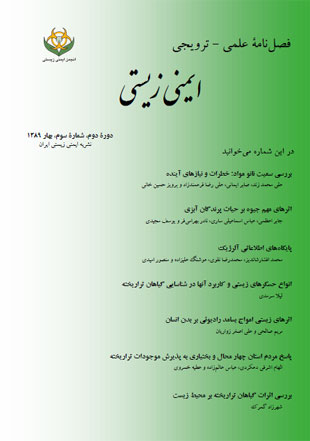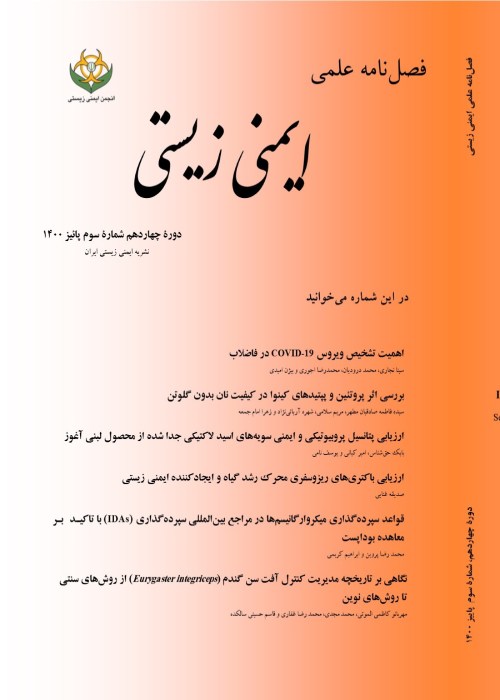فهرست مطالب

فصلنامه ایمنی زیستی
سال دوم شماره 3 (بهار 1389)
- تاریخ انتشار: 1389/01/20
- تعداد عناوین: 8
-
-
صفحه 35
-
معرفی کتابصفحه 97
-
Page 9With the expanding of using nano materials and determining the risks, concerns have been raised about the safety of this technology for human health and the environment. A number of nano-materials without determining the environmental problems are now available for users without an appropriate safety assessment that may have harmful effects for human and environment in long time. The effects of these materials strongly depend on their shape, dimensions, size and the amount of using or exposure time. Nano materials are used in a wide range of areas such as using in monoclonal antibodies, peptides and or drugs. One of the most common application of these materials is in to combating microbes. A number of nanomaterials toxicity and their effects on DNA and the immune system are proven. With the recognition of the toxicity effects of some of the nano materials, scientist decided to determine the permissive levels of using these materials to prevent the environmental pollution.Keywords: Environment, Toxicity, Gold, Nano materials, Silver
-
Page 23Mercury is one of the heavy metals that has not any useful role in animals body. Mercury xistence is each form has undesirable effect. This metal is one of the most important oncerns on aquatic ecosystems, since it can affect on biota from several aspects of eurology, physiology, behavior, and reproduction to be adversely affected. Many studies ave documented ataxia, lethargy, reduced appetite, reduced egg production, poor atching uccess, and aberrant parental care in birds exposed to mercury. Successful bird onservation strategies are dependent on a comprehensive understanding of the threats acing populations. Here, we discuss about importance of mercury result and ubsequently uggest priorities for future research in birds. This study represents important effects of ercury on valuable species and can be create an acceptable baseline for other esearchers. lso, it can be used by managers which they want to have control to reduce pollution, abitat protection and regeneration areas, especially important area for aquatic birds.Keywords: Aquatic birds, Mercury, Environment
-
Page 35Immunoinformatics is one of the branches of bioinformatics which has main role inmanagement and analysis of immunological information based on immunological databankinformation. Immunological databanks prepare to data access, derivation and analysis ofthese data. The efficiency of databanks information which is used for assessment ofengineered protein biosafety is related to nature and capacity of data bank which has beenused. In recent years, some databanks have been developed for assessment of protein’ssafety based on specific goals. These efforts have caused databanks with different accessionability, organization and information content. These differences have caused somelimitations on users for accession, transfer, derivation and mix of data. Hence, user’sawareness of the goals of designers or available tools within each databank can helpresearchers for optimum utilization of available data. In current study, we reviewedavailable allergenic databanks on the web.Keywords: Allergens, Alergenic, Biosafety, Immunoinformatics, Data bank
-
Page 49Transgenic plants are the important achievements of modern biotechnology in agriculturein recent years that an important part of the world food markets have conquered so thatcultivation of some varieties of plants even is more than their traditional counterpart. Withthe development of transgenic plants in world, tracing and evaluation methods of suchproducts are essential. Using new technologies such as microarrays and biosensors intracing of transgenic food products, due to high analysis speed and concurrent review arevery effective that still are in early stages of development. In case of applying thesemethods, fast analysis of food with less cost is desired. This paper introduces the use ofbiosensors and their application to identify transgenic plants.Keywords: Biosafety, Biosensor, Monitoring, Transgenic Plant, Genetically Modified Materials (GMMs)
-
Page 63There are a great amount of electromagnetic waves that we are exposed to them every day. Some of these waves present in our environment naturally, and the other part has been added to environment as human acivities. The electromagnetic waves in the range of radio frequency or RF, may have adverse and irreversible effects on human body. Some of RF generators are radio television antennas, satellites, mobile transmitters and receivers and microwave ovens. In this paper, the destructive effects of this waves and the results of the last related researches have been stated, and the thermal effects and the RF frequency effects are described. The defined standards by different centers, related to harmless radiation of RF per unit area and unit weight of a man have been mentioned in a separate section and finally the ways of protection and safety against this kind of radiation have been explained.Keywords: Biological effects, Safety standards, Radiofrequency waves, Electromagnetic waves, safety against waves
-
Page 73The acceptance of a new technology by consumers is the most critical stage in the development of that technology. This study investigated perception and attitude towards genetically modified organisms (GMOs) and biosafety in Chahar Mahal va Bakhtiary Province. A questionnaire containing personal information with 39 questions was prepared and distributed among participants in 1387. The results indicated that education level, education field and job had the highest impact on public perception of GMO and biosafety. Around 30% of respondents had no information about GMO and close to 33% of them disagreed with the production of these organisms. Around 60% of respondents agreed with biotechnology and transgenic plants and believed that they are necessary for modern agriculture. Near to 17% of participants had no information about biosafety and close to 33% of respondents had a little information about biosafty. More than 90 % of respondents were not familiar with biosafety regulations for controlling the risk of GMOs. Results indicated that mass media were not active in this field and they should play more effective role in this area to improve public perception about GMO and development the public acceptability of GMO.Keywords: Chahar Mahal va Bakhtiary Province, Biosafety, biotechnology, Genetically Modified Organisms (GMOs)
-
Page 85Many people in the world still live in extreme poverty and are without adequate nutrition, health and education. The ability to express foreign genes using transgenic technologies has opened up options for producing large quantities of commercially important industrial or pharmaceutical products in plants. Data from the biotechnology industry suggests that since wide-scale planting started in 1996, the area of transgenic crops grown globally has increased from 1.6 to 148 Mha in 2010. Despite this high adoption rate and future promises, there is a multitude of concerns about the impact of genetically modified (GM) crops on the environment. Before a transgenic crop can be placed on the market, regulators must be assured that, among other things, its cultivation poses no more risks to the environment than their traditional counterparts. The claimed effects of transgenic plants on environment are divided to direct (chemical interaction whit living things, change in persistence or invasiveness of the crop and gene flow by pollination to weeds and feral plants) and indirect effects (reduced efficiency of pests, disease, and weed control, effect on wildlife biodiversity and effect on soil and water.)Keywords: Unwanted effects, Modern biotechnology, Conventional agriculture, Transgenic plants, Environment


